Opening Night at Tanglewood: Levine conducts Mendelssohn and Tchaikovsky
Splendid performances open the Tanglewood summer
By: Michael Miller - Jul 11, 2007
Opening Night at TanglewoodFriday, July 6, 2007, Koussevitzky Music Shed, Lenox
Boston Symphony Orchestra, James Levine conductor
Heidi Grant Murphy Soprano, Kristine Jepson, mezzo-soprano
Women of the Tanglewood Festival Chorus, John Oliver conductor
Felix Mendelssohn, Overture, Op. 21, and Incidental Music, Op. 61, to "A Midsummer Night's Dream"
Pyotr Ilyich Tchaikovsky, Symphony No. 4, Op. 36
This was a routine opening night at Tanglewood only in appearance, only if one looked at the program, yawned, and decided not to come. James Levine not only made these familiar old warhorses fresh and compelling throughout, he established a new benchmark for the Boston Symphony Orchestra's steadily improving playing. Above all the Tchaikovsky Fourth, with his brilliant management of its somewhat unruly structure, showed him at the very height of his powers. The bad weather, which cleared up during the first half of the concert, affected only lawn attendance. The Shed appeared close to full, and there was a reasonably good crowd on hand for the truly magnificent fireworks which followed the concert.
Seated with first and second violins split left and right of the podium, as usual nowadays, the orchestra, fully deployed, played with the concentration and engagement of a chamber group, and this is what brought Mendelssohn's over-familiar music to life. Levine made the most of the long rests between the exquisitely balanced wind chords at the beginning of the overture. The strings, when they entered with their famous running figure, played with an attractive full sound and, after the first bars, with exemplary precision. Their articulation of the phrasing in these passages was a marvel. Levine showed no interest in tone-painting here, no evocation of fairies' wings or whispering nocturnal breezes, simply a beatifully played straighforward rendition of Mendelssohn's lively introductory music—which is absolutely legitimate and set the stage for a warmly satisfying treatment of the incidental music, which was by no means lacking in atmosphere. The women of the Tanglewood Festival Chorus evoked a fine sense of atmosphere in the choral parts, and Kristine Jepson and above all Heidi Grant Murphy sang their solo parts with a keen sense of style and the German Romantics' take on Shakespeare. The Wedding March came fully to life under Levine, with the massive brass choirs responding nimbly and enthusiastically to strings and woodwinds. This was a festive opening to what promises to be a great season at Tanglewood, and one of absolutlely top quality in musicianship and execution.
Tchaikovsky's Fourth Symphony, which he wrote in 1877, was a break-through work in the form for the composer, who had struggled with problems of structure and organization in his earlier symphonies, which doesn't mean that it is exactly a formal masterpiece either. Its vagaries are part of its charm, however, with its first movement of Brucknerian proportions, followed by simpler movements, an andantino and a scherzo, and concluding with an exuberant finale, which also returns to the conflicts of the first movement. Its many powerful mood swings reflect the chaos of Tchaikovsky's personal life at the time— his failed marriage and his struggles with his homosexuality—and give the work, above all its first movement, an unprecedented emotional and harmonic scope. It poses steep challenges for the conductor, who has to follow its emotional meanderings, but also hold the performance together, so that it makes dramatic and structural sense, which was no less a part of Tchaikovsky's achievement. Then the conductor needs to make the most of the finale's grand gestures without letting it sound bombastic.
Levine dealt with all these difficulties in the most brilliant way, and the orchestra played with tremendous commitment, energy, and precision. It seems that Levine's bridge to the Tchaikovsky Fourth is Mozart, a passion for whose music he shares with the composer. The responsive and clean ensemble, the alert interaction of woodwinds, brass, percussion, and strings, would do equally well for a Mozart symphony, Levine's bread and butter. Balances in the individual sections and in orchestral tutti were perfect, and the sound was extremely beautiful, like a Mozart symphony. The nuances of dynamics and the repertory of tone color Levine produced from the orchestra were astonishing, as well as the many subtle fluctuations in tempo in transitional passages in all four movements. The overall effect was tight and dynamic, but Levine and the players were able to explore the many musical byways of this complex work.
This was a performance to remember, one of James Levine's and the Boston Symphony's very greatest achievements, and entirely worthy to stand beside the Tchaikovsky of Koussevitzky, Monteux, and Munch.
Web: http://homepages.nyu.edu/~mjm11/index.html
e-mail: heliagoras@gmail.com






